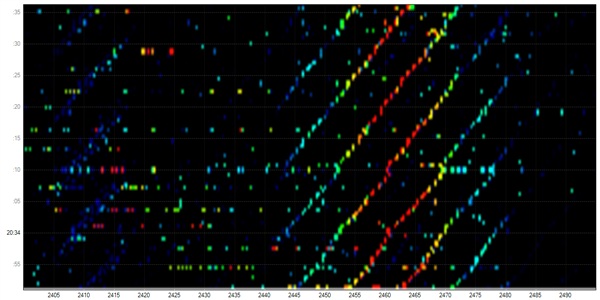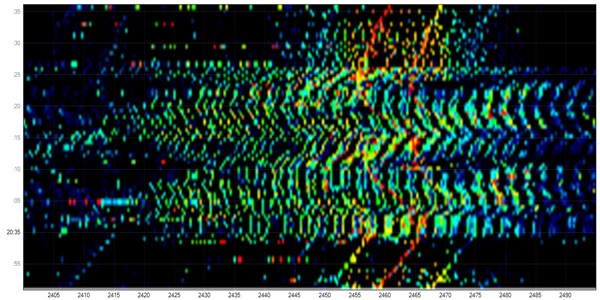Why does my microwave kill the Wi-Fi?
Every time I start the microwave in the kitchen, our home Wi-Fi stops working and all devices lose connection with our router! The kitchen and the Wi-Fi router are in opposite ends of the apartment but devices are being used a little here and there. We've been annoyed by the instability of the Wi-Fi for some time and it wasn't until recently we realized it was correlated to microwave usage.
After some testing with having the microwave on and off we could narrow down the problem to only occurring when the router is in b/g/n mode and uses a set channel. If I change to b/g mode or set channel to auto then there is no problem any more...but still!
The router is a Zyxel P-661HNU ("802.11n Wireless ADSL2+ 4-port Security Gateway" with latest firmware) and the microwave is made by Neff with an effect of 1000W (if this information might be useful to anyone). There is an "internet connection" light on the router and it doesn't go out when the interruption occurs so I think this is only an internal Wi-Fi issue.
Now to my questions:
- What parts of the Wi-Fi can possibly be affected by the microwave usage? Frequency? Disturbances in the electrical system?
- How can setting
Autoonchannelsmake a difference? I thought the different channels were just some kind of separation system within the same frequency spectrum? - Could this be a sign that the microwave is malfunctioning and slowly roasting us all at home? Is there any need to be worried?
Since we were able to find router settings that cooperate well with our microwave's demand for attention, this question is mainly out of curiosity. But as most people out there...I just can't help the fact that I need to know how it's possible :-)
Solution 1:
802.11 (b/g/n) operates on the 2.4 GHz ISM band. This is conveniently the same band that your microwave oven operates on. This isn't a coincidence, both operate in the 2.4 Ghz ISM band, because it can be freely used at low power without licence nearly anywhere in the world. Many other RF technologies including Bluetooth, walkie talkies, baby monitors, etc. also use the same band.
Most microwave ovens tend to be very well shielded and will not emit enough radiation1 to interfere with wireless communications. It is possible that your unit has a damaged shield. You could look into replacing it. That said, the amount of radiation a microwave has to "leak" for it to interfere with your wireless is tiny - 0.01% of it's output, roughly the same amount as your router or laptop, and far less than a typical mobile phone.
A better thing to do would be to upgrade your wireless networking equipment and devices to be 5 GHz compatible (used with 802.11 a/n/ac). This is the other major band WiFi networks can operate in, is capable of providing increased performance, and should not suffer interference from microwave ovens. You can tell if a device supports 5Ghz by checking if it lists "dual-band" capability, or supports 802.11a (e.g. "a/b/g/n") or 802.11ac. 5Ghz capable wireless equipment is becoming more widespread, but 2.4Ghz remains common in older and lower-end devices.
Addressing your different channels, microwave ovens (which should label the output frequency somewhere) should use ~2.450 GHz.
WiFi (b/g/n) channels typically range from 2.412 GHz to 2.472 GHz, with a bandwidth of 20 MHz and a 2 MHz band gap. If you pick a channel from the upper or lower end, and assuming your microwave oven is precise enough with its frequency, you could sidestep it entirely. This is, however, just a guess.

Click for full size
sourced from Wikipedia
1 I must point out that 2.4 GHz is far from ionising radiation, which is at least 2400000 GHz (the type that can harm human tissue and/or cause cancer). Even if the shield is faulty, it will not cause any harm. Any (very slight) damage would be caused by heating (and not directly by 'radiation'), which you most definitely will feel before any real damage. Also, just don't stand in front of it for hours a day. That always helps. Some countries also have regulations on the maximum energy allowed to be transmitted, ostensibly for human safety (there are other limits designed to reduce interference). Do note that such regulations tend to play far on the safe side, well below any level with concretely proven ill effects.
Solution 2:
Both microwaves and Wifi operate on the same frequency, 2.4 GHz. In theory, a "properly shielded" microwave shouldn't leak any radiation. However, in practice, they leak quite a bit.
Here is a blog post from one of the guys over at serverfault. They took a frequency analyzer, and looked at how various other 2.4 GHz devices (like microwaves and baby monitors) affect the Wifi spectrum.
This is what they found the Wifi spectrum to look like normally:

Those diagonal lines are the Wifi broadcast. There is almost no interference, so they are clear and easy to see.
This is what that same connection looks like with a typical microwave on:

As you can see, the microwave causes some serious interference.
To work around this, I'd recommend switching to wifi equipment which can operate in the 5 GHz band, like the latest 802.11n or 802.11ac routers.